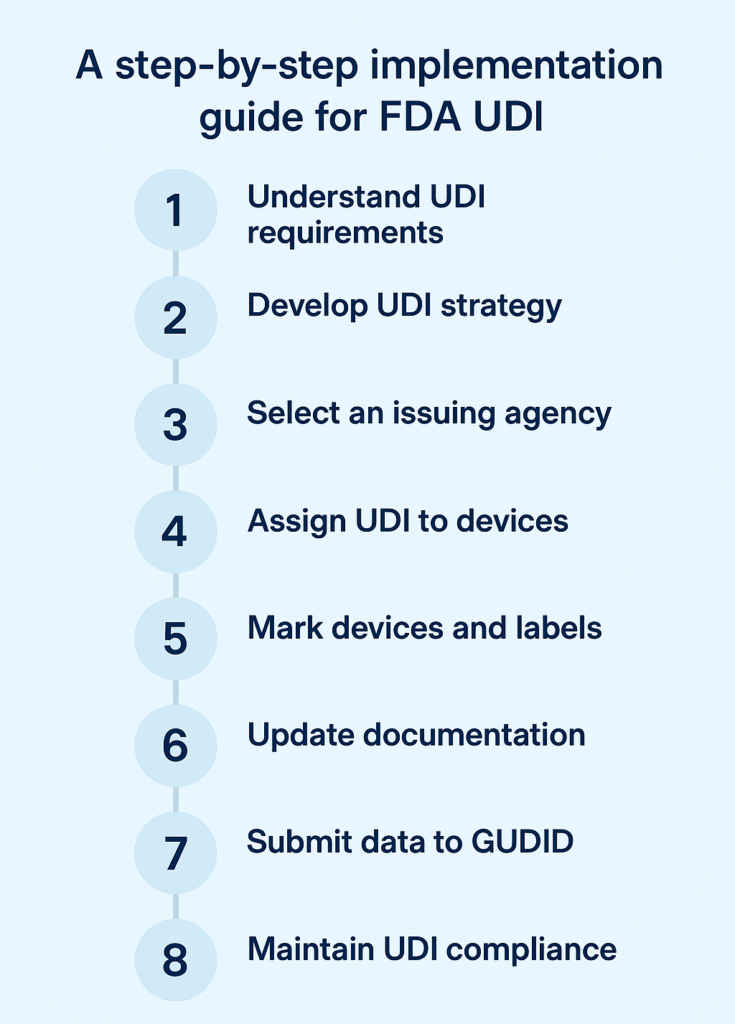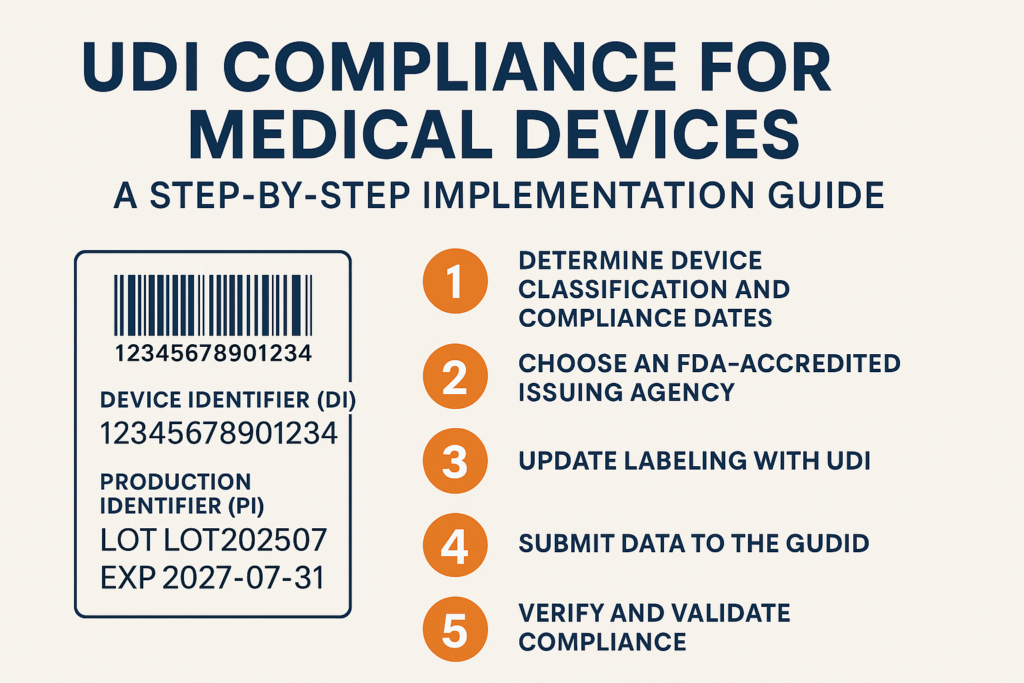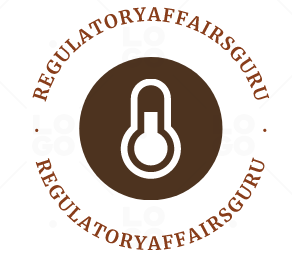A Step-by-Step Guide to Implementing UDI Compliance for Your Medical Devices
Your Medical Devices Regulatory Affairs Blog provides readers with enlightening information, intelligent simplicity, and action-driven design.

???? Introduction: Why UDI Compliance Matters
The FDA’s 21 CFR Part 830 Unique Device Identification (UDI) system is designed to:
✅ Improve patient safety by being able to trace medical devices.
✅ Facilitate expedited recalls and adverse event investigations.
✅ Improve hospital inventory and supply chain management.
✅ Enhance post-market surveillance by the FDA and foreign regulators.
Compliance with UDI is not a choice for MedTech manufacturers to enter the US market.
Non-compliance will result in:
❌ Customs detention or import issues.
❌ Refusal to receive shipments of the product.
❌Hospital and GPO distribution agreements may be delayed.
❌ Regulatory authority action.
UDI is not merely a labeling regulation but also a regulatory, operating, and market readiness mandate for device companies.
???? What is UDI?
UDI is a numeric or alphanumeric code that:
✅ Unambiguously identifies a model/version of a device worldwide.
✅ Gets printed on packs and labels of devices.
✅ Remains stored in the FDA’s GUDID (Global Unique Device Identification Database).
UDI Components:
1️⃣ Device Identifier (DI) (Static):
It serves to identify both a labeler and a specific model or version of a device.
These are issued by FDA-approved issuing organizations (HIBCC, GS1, ICCBBA).
2️⃣ Production Identifier (PI) (Dynamic):
Includes
Lot/batch number.
Serial number.
Expiration date.
Manufacture date.
Additional production details are also required.
Why it is needed in practice:
✅ Allows traceability in recalls, complaints, and adverse event investigations.
✅ Allows hospitals to automate inventory control.
This feature enables the FDA and international regulators to efficiently track post-market safety.
Example:
A Class II glucose meter:
DI: 01234567890123 (issued by GS1).
PI: LOT202507, EXP20270731.
This makes it simple to:
✅ Rapidly scan through hospital systems.
✅ Good identification of recalled affected devices.
???? UDI Regulatory Environment
In the US:
The FDA regulates UDI under
✅ 21 CFR Part 830: Establishes UDI system requirements.
✅ 21 CFR Part 801.20: Requires devices with UDI on the label and packaging.
✅ DI data is to be reported to GUDID.
Internationally:
✅ EU MDR/IVDR requires UDI on CE-marked devices (Article 27 MDR).
✅ China, Saudi Arabia, South Korea, and Australia have adapted to global UDI standards.

???? Step-by-Step: UDI Implementation Roadmap
1️⃣ Classify Your Device and Identify the Compliance Deadline
FDA UDI deadlines by device class:
Class III (life-supporting/life-sustaining): September 2014 mandatory.
Class II: Since September 2016.
Class I and Unclassified: Labeling has been mandatory since September 2022.
Action: Understand your device’s classification and compliance status to avoid regulatory pitfalls.
2️⃣ Select an FDA-Accredited Issuing Agency
FDA accepts:
✅ GS1 (most widely utilized globally).
✅ HIBCC (for medical use).
✅ ICCBBA (for blood, cell, and tissue products).
Steps
✅ Register with your preferred issuing organization.
✅ Get to know their coding system.
(i.e., GTIN in GS1).
✅ Generate DI codes for every version/model of devices.
Pro tip: GS1 is adopting global UDI guidelines for EU MDR/IVDR, making it easier to get compliant worldwide.
3️⃣ Update Labeling with UDI
You must:
✅ Human-readable UDI in readable form on packages and labels.
✅ Machine-readable UDI code (1D/2D barcode or RFID).
In reprocessed devices, the following reprocessing is done before use:
✅ Permanent direct marking on the device itself, except where exempted.
## Checklist:
The label includes DI and PI.
The label format has been tested for readability and durability.
Labels are applied uniformly to batches of manufacture.
4️⃣ Submit DI Data to the GUDID
The Global Unique Device Identification Database (GUDID):
✅ Retains DI data about your device.
Regulators, healthcare professionals, and supply chain partners can search it publicly.
Steps:
✅ Register with a GUDID account using:
FDA Electronic Submissions Gateway (ESG).
Manage your account with your issuing organization for direct submission.
✅ File DI data like:
Brand name.
Version/model number.
The FDA product code is also provided.
Consider the device’s size, packaging, and description.
✅ Refresh records whenever:
Label changes.
The device is discontinued.
The packaging configuration undergoes modifications.
5️⃣ Roll Out UDI in Your QMS and ERP
UDI is not a one-off activity; it requires
✅ Integrate your quality management system (QMS) for:
Managing complaints is a crucial aspect of UDI.
CAPA integration.
Post-market surveillance.
✅ Integration with your ERP system to ensure:
Proper DI/PI mapping to manufacturing lots.
The system ensures the automated printing of labels in the correct UDI.
✅ Integration with:
Hospitals and distributors utilize supply chain solutions.
Recall management processes.
6️⃣ Train Your Team
Train:
✅ Production and packaging teams on label creation, application, and reading.
✅ Regulatory teams work on GUDID updates and DI/PI management.
✅ Quality traceability teams respond to recalls and complaints.
7️⃣ Ensure UDI Compliance
Pre-scaling:
✅ Intended scanner readability testing for the barcode.
✅ Durability testing of the barcode in shipping and storage.
✅ Ensure your serialization and batch process is PI-generation compliant.
✅ Regular auditing of GUDID data for accuracy.
⚠️ Steer Clear Of These Expensive Missteps
❌ Poor rollout of barcode printing, leading to scanning mistakes.
❌ Incomplete or inaccurate submission of DI information to GUDID.
❌ Not performing direct marking on reusable devices where possible.
❌ Not mapping ERP batch data to UDI labeling.
❌ Not factoring in international UDI harmonization requirements when going global.
UDI, Best Practices for Compliance
✅ Pre-market, not post-market, planning for the implementation of UDI.
✅ Use of GS1, where a globalization strategy is contemplated.
✅ Validate the Standard Operating Procedures (SOP) to ensure the legibility of labels and the integrity of data.
✅ Internal device master UDI table.
✅ Conduct internal UDI process audits regularly.
✅ Keep up with the most current FDA guidelines and international standards to ensure compliance.
Real-World Case Example
One of the MedTech firms had its Class II wearable device red-flagged during an FDA audit due to UDI non-labeling, which affected the product launch.
Action taken:
✅ Collaborated with GS1 in GTIN-based DI code implementation.
✅ Recreated label art to include 2D Data Matrix barcodes.
✅ Integrated UDI with ERP and labeling print processes.
✅ Published devices on GUDID.
✅ Trained production staff in scanning and labeling.
Outcome: Met with FDA compliance, cleared shipments, and started scaling with large hospital distributors.
???? UDI Compliance Advantages
✅ Enables access to the US market and ongoing distribution.
✅ Helps enable successful recalls if needed.
✅ Encourages hospital trust for contracting and inventory systems.
✅ Enhances post-market surveillance and patient safety.
✅ Put your company in a position to expand globally under EU MDR and beyond.
📚 References
1️⃣ FDA UDI Overview: https://www.fda.gov/medical-devices/unique-device-identification-system-udi-system
2️⃣ 21 CFR Part 830 – Unique Device Identification: https://www.ecfr.gov/current/title-21/chapter-I/subchapter-H/part-830
3️⃣ 21 CFR 801.20 – UDI Labeling Requirements: https://www.ecfr.gov/current/title-21/chapter-I/subchapter-H/part-801/section-801.20
4️⃣ GUDID Submission Guidance: https://www.fda.gov/media/93580/download
5️⃣ GS1 UDI Implementation Guide: https://www.gs1.org/standards/udi
6️⃣ HIBCC UDI Resource: https://www.hibcc.org/udi/
7️⃣ ISO/TR 20416:2020 – Medical Devices Post-Market Surveillance: DOI 10.3403/TR20416
8️⃣ BfArM EU UDI Implementation Study: DOI 10.1007/s00262-020-02626-7
